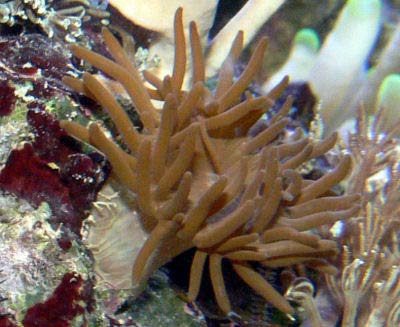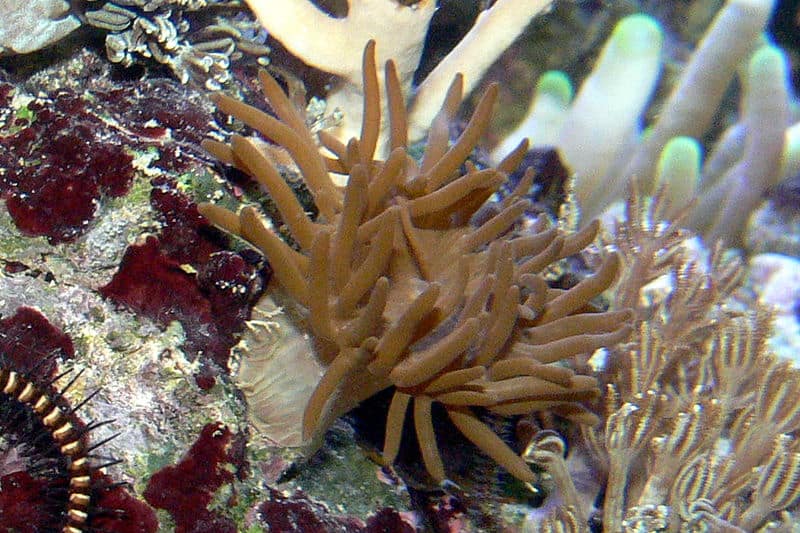
The Manjano Anemone is such a cute little thing, that it is hard to imagine how quickly… and thoroughly, it can overrun your tank!
The Manjano Anemone Anemonia manjano, also called Anemonia Majano, vies with the Aiptasia Glass Anemones as the top pest anemone in saltwater and reef tanks. Like these other pesky anemones, it doesn’t have a very good reputation with saltwater hobbyists. They have strong stings and don’t “play nice” with other corals and fish. They use venomous cells, nematocysts found in their tentacles, to sting corals and fish. They can be a challenge to get rid of and have been known to take over a reef aquarium by quickly reproducing, while stinging and killing other tank invertebrates.
Like the Aiptasia, the Majano Anemone is a hitchhiker on live rock. The best way to avoid problems in an aquarium is to use a quarantine tank. Put all new live rock, as well as every animal you bring in, into a quarantine tank for observation and care before introducing them into your main tank. Without a good quarantine period, these anemones can easily be introduced into the aquarium and become a problem.
The Manjo Anemone can quickly reach plague proportions in captivity. Corals and other anemones are the most affected by this pest. This anemone needs to be removed as soon as possible. Once this pest anemone achieves a foothold, manual removal to keep populations in check, may very well become an ongoing activity. Natural predators such as the Peppermint shrimpLysmata wurdemanni can be added to control them. But the problem is, these same predators may also go after some of your desirable corals.
Yet for those who want to keep this anemone in its own display, or in a refugium, it sure is cute. This lovely pest anemone looks like a miniature Bubble Tip. They are quite small, only reaching up to 1.5″ (3 cm) in diameter. Their column color is greenish brown to tan and their tentacles have white or light tips. They love light and will work their way up the rockwork to the top of the tank.
For more about the types of Sea Anemone Species, see:
Sea Anemone – Tube Anemone
- Minimum Tank Size: 1 gal (4 L)
- Aquarist Experience Level: Beginner
- Temperament: Aggressive
- Temperature: 68.0 to 83.0° F (20.0 to 28.3° C)
- Size of organism – inches: 1.5 inches (3.81 cm)
- Diet Type: Carnivore
- Suitable for Nano Tank: Yes
Habitat: Distribution / Background
Sea Anemone Facts: The Manjano Anemone Anemonia manjano (formerly majano) was described by Carlgren in 1900. The Anemonia genus is a member of the Actiniidae family, and this genus contains 22 species. Some other common names it is known as are Majano Anemone, Anemonia Majano, and Manjo Anemone. Anemonia manjano is not on the IUCN Red List for endangered species.
Where are Sea Anemones Found: This anemone is found in the Indo-Pacific, Fiji and Indonesia..
Sea Anemone Habitat: The Anemonia anemones are generally found where there is hard substrata in shallow water. They will form dense colonies in areas of shallow water. They generally eat zooplankton, but will always accept other food particles.
Sea Anemone Species: There are 22 species in the Anemonia Genus. The most familiar species is the one being described here, A. manjano, formerly spelled “majano“, followed by the Snakelock Anemone or Snakelocks Sea AnemoneAnemonia viridis and the Mediterranean Snakelocks Sea AnemoneAnemonia sulcata.
- Scientific Name: Anemonia manjano
- IUCN Red List: NE – Not Evaluated or not listed
Description
Appearance of a Sea Anemone: The Anemonia manjano has a pedal column with a sticky foot that they use to adhere to anything. They also use this “foot” to move until they find a new spot. The color is greenish brown to tan. Tentacles, covering the top surface or oral disc, have white or light tips. The mouth is in the center of the oral disc, it can be light like the tentacle tips as well. These anemones can grow up to 1.5″ (3 cm) in diameter.
Sea Anemones Life Cycles: It is unknown how long Anemonia can live. They reproduce quickly, creep over all surfaces and crowd out desirable corals. Eventually, they can overtake an entire reef system.
- Size of organism – inches: 1.5 inches (3.81 cm)
- Lifespan: – It is unknown how long Anemonia can live.
Difficulty of Care
Sea Anemone Care: Some aquarists use Anemonia in their refugiums to take out nutrients from the water. Manjano Anemones are moderate to care for because they do need stronger lighting. They have the ability to reproduce rapidly in saltwater aquariums where there are plenty of nutrients and good lighting. This anemone as well as the Aiptasia anemones are generally regarded as a pests. They can be difficult to control and/or eliminate once they obtain a foothold.
- Aquarium Hardiness: Very Hardy
- Aquarist Experience Level: Beginner
Foods and Feeding
What Do Sea Anemones Eat: The Manjano Anemone is a carnivore. In the wild Anemonia derive nutrition from their symbiotic algae, zooxanthellae, as well as from the water around them. They use their tentacles to capture organic matter that floats by, then insert the food into their mouths for ingestion. They generally eat zooplankton, but will always accept other food particles.
- Diet Type: Carnivore
- Meaty Food: All of Diet
- Feeding Frequency: Seldom
Aquarium Care
Water changes of 10% bi-monthly or 20% a month are typical for most anemones, but with Anemonia, the more nutrients you have the happier it will be.
- Water Changes: Monthly
Aquarium Setup
Using Anemonia in refugiums to take out nutrients can be effective, yet it can also be risky if any parts of an Anemonia migrate to the main tank through the filtration. The typical reef environment is best for these anemones. Like most anemone species, they need live rock or some other solid material they can attach to. In a refugium use screening to prevent free floating Anemonia from migrating to your main tank. Be sure to have all of your pumps covered. Most good quality pumps have guards on them.
- Minimum Tank Size: 1 gal (4 L)
- Suitable for Nano Tank: Yes
- Live Rock Requirement: Typical Amount
- Substrate Type: Any
- Lighting Needs: Moderate – normal lighting – Moderate to high.
- Temperature: 68.0 to 83.0° F (20.0 to 28.3° C)
- Specific gravity: 1.023-1.025 SG
- Water Movement: Moderate – Low to Moderate.
- Water Region: All – They are attracted to light, and will climb the live rock to get to the top.
Social Behaviors
These are aggressive anemones. Saltwater hobbyists don’t purchase these anemones, rather they are acquired accidentally and they are able to out compete other species in the reef tank. By using venomous cells or nematocysts found in their tentacles, they sting and push other inhabitants away from their “turf”. They have strong stings that can harm, and even kill other corals and fish. After splitting, anemones will tolerate their own “clones” and won’t stop repopulating.
Sea Anemone Predators: Natural predators such as the Peppermint shrimpLysmata wurdemanni can be added to control them. But these same predators may also go after some of your desirable corals.
Other natural predators are dwarf angels from the Centropyge genus, large angels from the Pomacanthus genus, and angelfish from the Apolemichthys Genus such as the Three-spot AngelfishApolemichthys trimaculatus, Indian Yellow-Tail AngelfishApolemichthys xanthurus, and Black-banded AngelPomacanthus arcuatus. Angelfish can wreak havoc on reef systems as they get older, but certain angels may do well in your system. Which angelfish to get depends on the type of corals you choose to have.
- Venomous: Yes
- Temperament: Aggressive
- Compatible with:
- Same species – conspecifics: Sometimes
- Anemones: Monitor
- Mushroom Anemones – Corallimorphs: Monitor
- Leather Corals: Threat
- Shrimps, Crabs, Snails: Monitor – Peppermint shrimp Lysmata wurdemanni are a natural predator.
- Stony Corals: Threat – is aggressive
- Soft Corals: Threat – is aggressive
Sex: Sexual differences
No sexual difference in appearance is known.
Breeding / Reproduction
Propagating Anemonia anemones is fairly easy, just cut a piece off and it will grow. Anemones in general can multiply by sexual and asexual means. The Manjano Anemone will multiply asexually by fission, which is where a tiny bit of tissue detached from the foot quickly develops into a new and complete anemone. They will tolerate their own “clones”, and these anemones are very prolific.
- Ease of Breeding: Easy
Ailments / Diseases
Problems for the Manjano Anemone or Majano Anemone are pretty minimal unless your lighting, water movement, feeding and water quality are extremely low. Then your anemone will detach to look for “better conditions.” With better conditions, they can quickly multiply, and having a quickly expanding population of Anemonia then becomes the problem.
For information on pest anemone removal and control, see: Aiptasia Pests – Getting Rid of Glass Anemones.
Availability
Buy A Sea Anemone: Saltwater aquarists don’t usually buy Manjano Anemones, aquarists generally acquire them as hitchhikers, arriving with live rock.
References
- Animal-World References Marine and Reef
- Ronald L. Shimek, Guide to Marine Invertebrates: 500+ Essential-to-Know Aquarium Species, Microcosm, 2005
- Alf Jacob Nilsen and Svein A. Fossa, Reef Secrets: Starting Right, Selecting Fishes & Invertebrates, Advanced Biotope Techniques, T.F.H Publications inc., 2003
Feueranemone (Image Credit: Haplochromis, Wikimedia Commons CC BY-SA 3.0 Unported)
